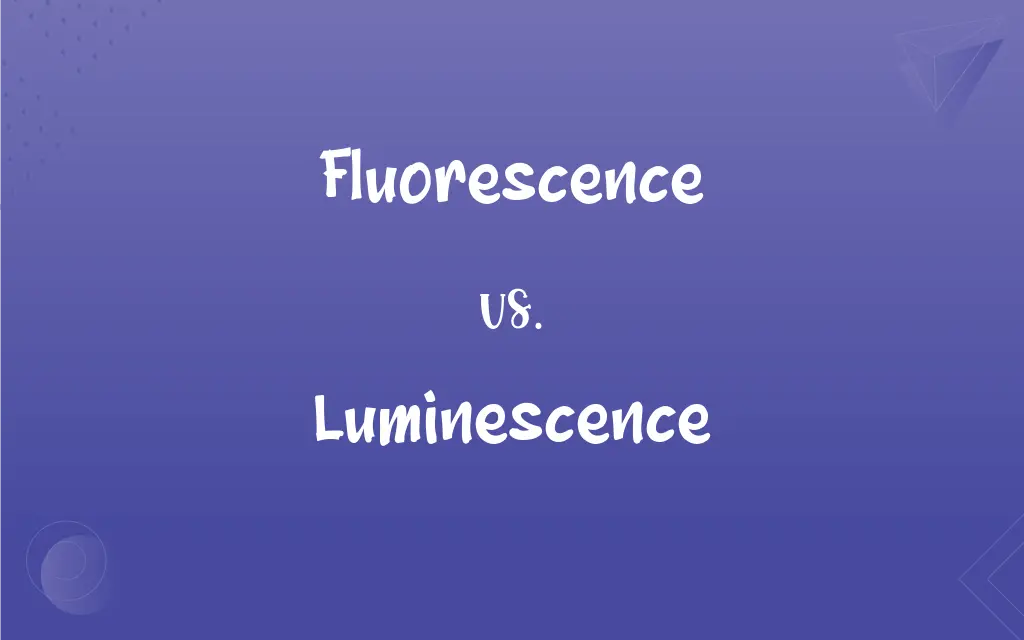Fluorescence vs. Luminescence: What's the Difference?
Edited by Aimie Carlson || By Harlon Moss || Published on November 11, 2023
Fluorescence is a type of luminescence where light is emitted by a substance after absorbing light, whereas luminescence is the emission of light not resulting from heat.

Key Differences
Fluorescence is a phenomenon that falls under the broader category of luminescence. When a material exhibits fluorescence, it absorbs photons and re-emits them almost immediately, without a noticeable delay. Luminescence, on the other hand, is a general term describing any emission of light from a substance not caused by heat.
Both fluorescence and luminescence play vital roles in various scientific, technological, and artistic applications. While fluorescence is often associated with dyes, markers, and specific biological processes, luminescence can encompass other light-emitting phenomena such as phosphorescence, chemiluminescence, and bioluminescence.
In essence, all fluorescent materials are luminescent, but not all luminescent materials are fluorescent. This distinction is primarily based on the duration and mechanism of light emission. Luminescence covers any form of cold light emission, whereas fluorescence is a rapid, short-lived emission following light absorption.
The study of both fluorescence and luminescence is crucial for understanding many natural processes and man-made technologies. From deep-sea creatures that exhibit bioluminescence to fluorescent tags used in molecular biology, the manifestations of these phenomena are diverse and fascinating.
Comparison Chart
Definition
Light emission after photon absorption.
Light emission not caused by heat.
ADVERTISEMENT
Duration
Short-lived.
Can be short-lived or long-lasting.
Types
A subset of luminescence.
Includes fluorescence, phosphorescence, etc.
Common Applications
Biological markers, dyes.
Glow-in-the-dark materials, deep-sea creatures.
Triggering Mechanism
Requires initial photon absorption.
Can be triggered chemically, biologically, etc.
Fluorescence and Luminescence Definitions
Fluorescence
Subset of luminescence.
Among the various luminescent phenomena, fluorescence is often used in labs.
ADVERTISEMENT
Luminescence
General term for cold light emission.
Bioluminescence is a type of luminescence seen in some marine creatures.
Fluorescence
Common in biological markers.
The protein's fluorescence made it easily detectable.
Luminescence
Can be caused by chemical reactions.
The reaction gave off a cold luminescence, illuminating the tube.
Fluorescence
Requires photon absorption to emit.
Without UV exposure, the material displayed no fluorescence.
Luminescence
Includes phenomena like phosphorescence.
The prolonged glow of the material was due to its luminescence.
Fluorescence
Immediate light emission after absorption.
The dye showed bright fluorescence under UV light.
Luminescence
Emission of light without heat.
The glow stick displayed vivid luminescence in the dark.
Fluorescence
Short-lived light emission.
The fluorescence faded quickly once the light source was removed.
Luminescence
Not solely dependent on prior light absorption.
The luminescence of fireflies is a result of a chemical reaction.
Fluorescence
The emission of electromagnetic radiation, especially of visible light, stimulated in a substance by the absorption of incident radiation and persisting only as long as the stimulating radiation is continued.
Luminescence
The emission of light that does not derive energy from the temperature of the emitting body, as in phosphorescence, fluorescence, and bioluminescence. Luminescence is caused by chemical, biochemical, or crystallographic changes, the motions of subatomic particles, or radiation-induced excitation of an atomic system.
FAQs
How long does fluorescence typically last?
Fluorescence is usually short-lived, ceasing almost immediately after the removal of the exciting light.
Are all luminescent materials fluorescent?
No, while all fluorescent materials are luminescent, not all luminescent materials are fluorescent.
What causes luminescence in materials?
Luminescence can be triggered by various factors, including chemical reactions, biological processes, or absorbed light.
What's the difference between fluorescence and phosphorescence?
Fluorescence is short-lived, while phosphorescence can last longer after the excitation source is removed.
Can luminescence occur at room temperature?
Yes, luminescence is often referred to as "cold light" as it can occur without the production of heat.
What causes the colors in luminescence?
The colors in luminescence are determined by the energy differences in the electronic transitions within the material.
Is bioluminescence a form of luminescence?
Yes, bioluminescence is a type of luminescence caused by biological processes.
How is luminescence different from incandescence?
Incandescence is light emission due to heat, while luminescence is light emission not caused by heat.
Is luminescence visible in daylight?
Luminescence can be overshadowed by ambient light in daylight, but it's more noticeable in the dark.
How is luminescence utilized in nature?
Examples include fireflies exhibiting bioluminescence and certain deep-sea creatures using luminescence for attraction or camouflage.
Is fluorescence a type of luminescence?
Yes, fluorescence is a subset of luminescence.
Why do some materials only show fluorescence under UV light?
UV light provides the energy required for certain materials to absorb and re-emit light in the visible spectrum as fluorescence.
What's the primary application of fluorescence in biology?
Fluorescence is widely used as markers or tags to study biological molecules and processes.
Can humans exhibit fluorescence?
Under certain UV light conditions, human teeth and eyes can exhibit a form of fluorescence.
Do all materials that absorb UV light exhibit fluorescence?
No, not all materials that absorb UV light will exhibit fluorescence; it depends on their molecular and atomic properties.
Are fluorescent lights and luminescent lights the same?
No, fluorescent lights are a specific type of luminescent light where fluorescence is the primary mechanism.
Do all luminescent phenomena require light absorption like fluorescence?
No, while fluorescence requires light absorption, other forms of luminescence can be triggered by chemical or biological factors.
Are glow sticks an example of luminescence?
Yes, glow sticks exhibit chemiluminescence, a type of luminescence caused by chemical reactions.
Can fluorescence be used in medical imaging?
Yes, fluorescence is used in certain imaging techniques to highlight specific tissues or molecules.
Can luminescence be artificially created in labs?
Yes, luminescence can be artificially produced and is utilized in various applications, from research to consumer products.
About Author
Written by
Harlon MossHarlon is a seasoned quality moderator and accomplished content writer for Difference Wiki. An alumnus of the prestigious University of California, he earned his degree in Computer Science. Leveraging his academic background, Harlon brings a meticulous and informed perspective to his work, ensuring content accuracy and excellence.
Edited by
Aimie CarlsonAimie Carlson, holding a master's degree in English literature, is a fervent English language enthusiast. She lends her writing talents to Difference Wiki, a prominent website that specializes in comparisons, offering readers insightful analyses that both captivate and inform.







































































